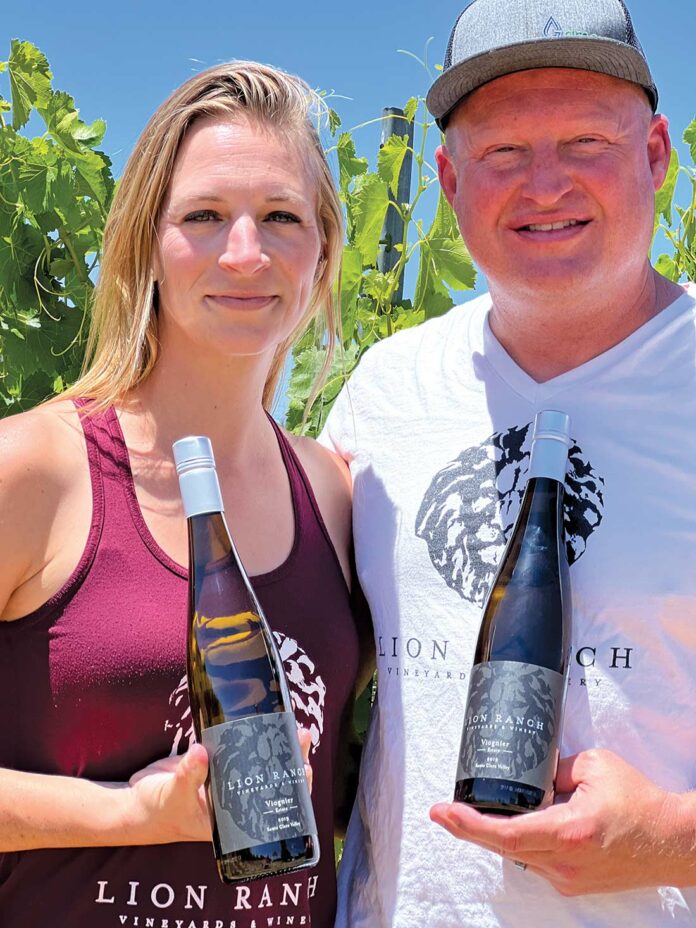
Kim and Todd Englehardt are dedicated to Rhone varieties at their Lion Ranch vineyard in San Martin, where they have two parcels: a two-acre site at the tasting room, which is all reds, and two-and-a-half acres of mixed whites and reds at their additional five-acre parcel down the road. They started out growing Grenache Blanc, Marsanne, Picpoul Blanc, Roussanne and Viognier for whites, and Cinsault, Counoise, Grenache Noir, Mourvedre and Syrah for reds.
And they’re just getting started.
The Englehardts intentionally spaced their vineyards at seven-by-four feet (for whites) and seven-by-five (mostly reds), to force a smaller yield per vine, hopefully increasing grape quality. Theoretically, this should extend the vine’s lifespan as well.
It is safe to say their approach to winemaking falls into the fresh and vibrant camp, rather than the extracted, ripe and oak-dominant camp. They eschew the use of oak barrels entirely, choosing instead to embrace the concept of 30-inch French oak staves that are bound together like a fan with food-grade stainless steel. These are placed directly into the tanks.
“Our intent was to produce elegant, high-acid, unique Rhone-style wines, and try to eliminate any chances of wine ‘flaws,’ by reducing oxidation and volatile acidity,” Kim Englehardt said. “We submerge multiple oak fans into each tank while the wine ages—usually 18 months. This allows the characteristics and benefits of the French oak without the downsides. So far, this system has worked wonderfully.”
She noted that they stopped oaking their Rhone whites after the first few vintages, discovering that it covered up the subtleties of these nuanced wines.
Finding themselves with a bit of excess Viognier in 2017, and having read about “orange” wines, they decided to experiment with skin contact, which is how you ferment reds, but typically not whites.
“The 100% skin contact Viognier was bold, delicious and interesting, but we felt our customer’s expectations about Viognier are quite different,” Englehardt said.
So they did a blend of 55% direct press and 45% skin contact, which resulted in what she calls “a unique and stylistic wine.” In 2018, they went to a 80% direct press, 20% skin contact ratio, which she feels provides slightly more mouthfeel and body, and extends the finish considerably. They found that adding a small amount of skin contact Viognier to their Marsanne also added that magic touch.
Syrah and Viognier are often co-fermented in the Northern Rhone region of Cote Rotie in France to add aromatics to the dark and powerful red.
“We find the wines from this region to be wonderfully elegant and lean, without the reductive nature that oftentimes overshadows Syrahs from other regions,” Englehardt said. “The simultaneous fermentation of Viognier with Syrah adds elegance, mildly floral aromas, and eliminates the reductive burnt rubber aromas.”
As an homage to this style, the Englehardts purchased Syrah fruit from the famous Besson Vineyard in Gilroy in 2018 and did a true “co-ferment” of Syrah with their estate Viognier.
“We couldn’t be more excited about the uniqueness of this wine,” Englehardt said. “We also utilize skin-contact Viognier in small amounts with other red blends, which we have done post-fermentation at blending. This adds similar elegance and floral aromas to many of our red wines.”
The Englehardts are also big fans of the white wines of Chateauneuf du Pape.
“We grow Roussanne, Grenache Blanc and Picpoul Blanc,” she said. “And, while we do not yet grow Bourboulenc, Clairette Blanche or Picardan, we may end up growing some in the future.”
Each year, they make a blend of the three called Cuveé Blanc, and have grafted more Grenache Blanc and Picpoul, as they enjoy the freshness of these two varieties.
Going all in on the Rhone theme, in the spring of 2019, they grafted some of their Viognier vines over to the last three Chateauneuf du Pape reds they didn’t already have: Terret Noir, Muscardin and Vaccarese. The graft canes came from UC Davis where they were quarantined after budwood was imported by Tablas Creek from France. Suffice it to say that nobody else in the Santa Clara Valley grows as many Rhone varieties, and certainly no one else has these three rare birds.
“We now grow all eight red grapes traditionally found in Chateauneuf du Pape, and 2020 was our first vintage we harvested and blended all eight grapes into our newest (and yet unreleased) red blend, called ‘Alpha,’” Englehardt said.
This blend was done with native yeast and whole cluster, aged 18 months, and bottled unfined and unfiltered in May 2022. It will be released within the next year.
However, Englehardt said that the 2022 vintage is looking light for many of their white Rhone varietals.
“We had an atypically late freeze on May 7, 2022, and lost a large majority of the fruit from our Grenache Blanc, Picpoul Blanc and some of our Roussanne,” she said. “While the vines have recovered nicely and have survived, they have nearly no clusters remaining. Since we’ve grafted over more Picpoul Blanc in 2019, we strive to produce 100 cases per year of a single varietal, and still have enough to go into the Cuveé Blanc. Sadly, this year, we may have almost no Picpoul Blanc.”
And so it goes in farming. Better snap up those Lion Ranch Rhone whites while they last. That 2018 Syrah is pretty tasty, too.













